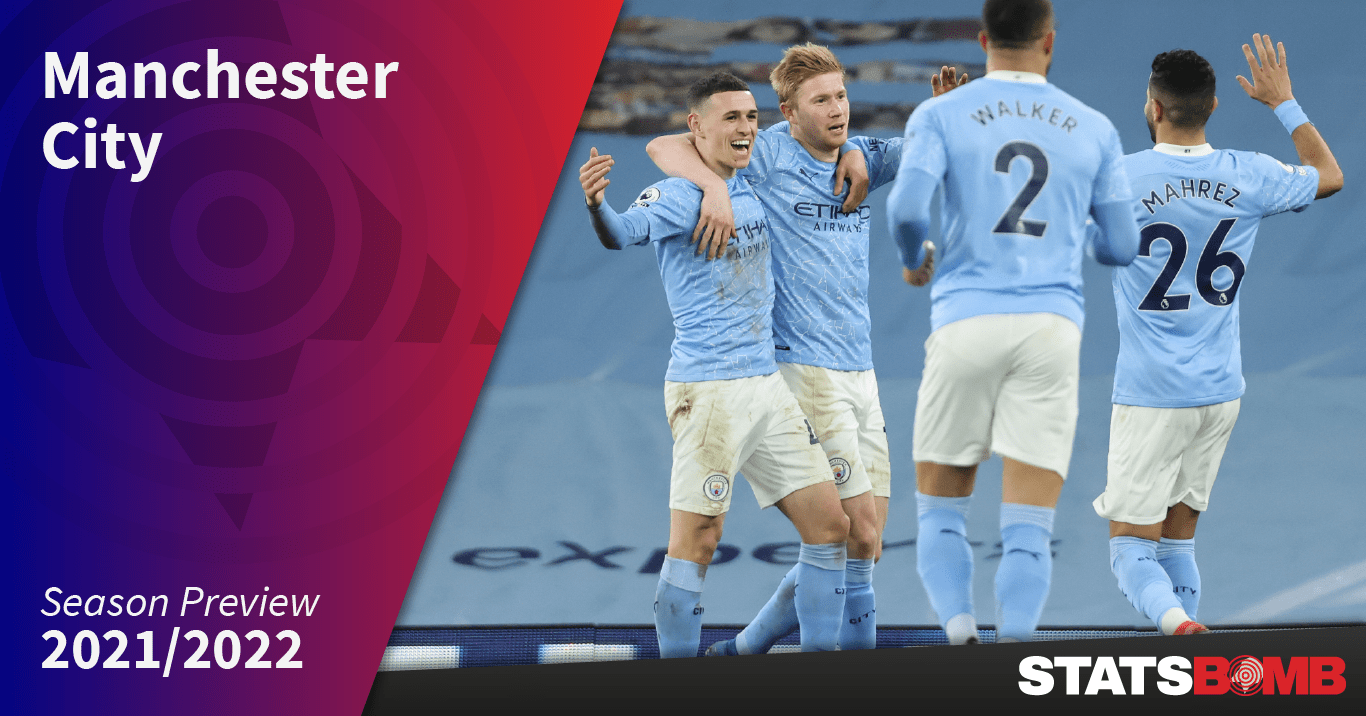For the third time in four seasons, we’re previewing Manchester City as the reigning Premier League champions. They’re odds-on with the bookmakers to make it four titles in five, but two consecutive sub-90-point seasons could suggest that they’re within arm’s reach of their rivals and with seemingly more arms set to reach for them in this campaign than in recent seasons as well.
Ultimately, City won the 2020/21 title comfortably, with a 12-point lead over 2nd placed Manchester United at the curtain fall, but it took them some time to get going.
On the back of their struggles in 2019/20, the W3-D3-L2 start to the new season did nothing to allay fears that City’s – and Guardiola’s - reign of dominance could be over. After the defeat to Tottenham on the 22nd of November, they were 13th, eight points behind Spurs and rivals Liverpool. Those eight games had seen all sorts of calamity: a 5-2 defeat to Leicester on matchday 2 saw City concede three penalties, before a run of six games in which they scored just five goals. After years of goals overflowing from the City attack, the well had suddenly run dry.
The drought was not a tale of poor finishing either: the underlying numbers dropped right off, to the extent that the first 15 games of the 2020/21 season saw City create fewer expected goals than in any other 15-game spell during Guardiola’s time in charge in Manchester.
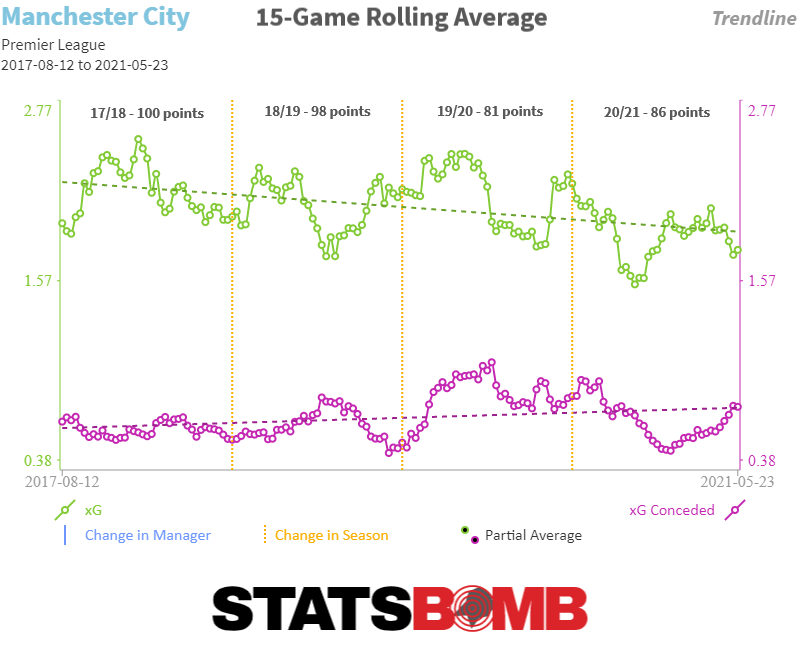
Even including their annual 5-0 flattening of Burnley, City scored just 18 goals in their opening 12 games; for perspective, they’d scored 40, 36, and 35 by that stage in the three campaigns prior. Something had to change, and Guardiola knew it.
“The reason (for the lack of goals) is the manager – I have to find a way, use their qualities and adapt. I have to adjust something, to let them feel we can create more. It’s in my hands to help.”
Adjust it he did. Guardiola changed the shape to get more bodies into dangerous positions when City were controlling play in the final third, and two of the main storylines of Manchester City’s season developed off the back of these tweaks: the emergence of João Cancelo and the resurgence of İlkay Gündoğan.
Cancelo was brought inside from “right back”, taking up positions more associated with a right-sided ‘8’ than a lateral defender. After this change, the Portuguese full-back hit his best form in a blue shirt, connecting the City attack and playing numerous searching passes from an inside position: Cancelo finished the season behind only Kevin De Bruyne in the City team for open play passes into the penalty area per 90 minutes played. In the Premier League, it was only Trent Alexander-Arnold and Jack Grealish, and De Bruyne, that finished ahead of him.
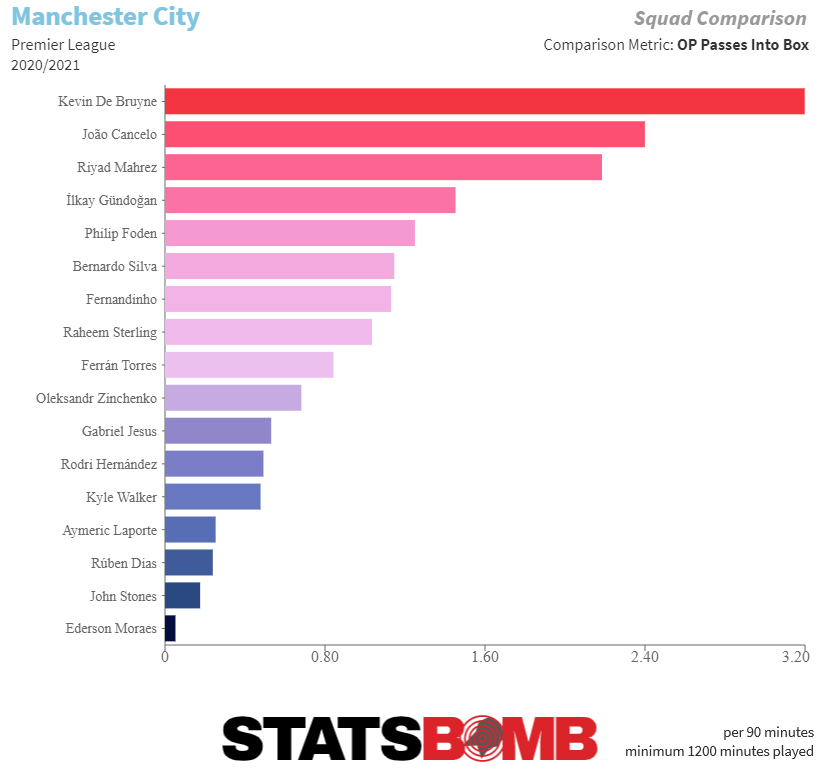
Another change saw Gündoğan given the freedom to push on and invade the space around and beyond the defensive line. It took a while to take effect; the midfielder notched just two goals before January, but ghosted into the box repeatedly in the second half of the season to end the season on 13 goals.
Contrast the pass maps of the games against West Ham early in the season and the post-tweaks fixture versus Brighton. Against West Ham, it’s clear City had a lot of possession in deeper areas but lacked penetration. The full-backs created the width, the wingers tucked inside, but the attack as a whole was disconnected. Against Brighton, the wingers stayed high and wide; Cancelo drifted inside, and all-in-all the attack was far better functioning. The new shape of the team powered City to a run of W20-D2-L1 between November and March, a run that included 15 wins in a row and powered them to the title.
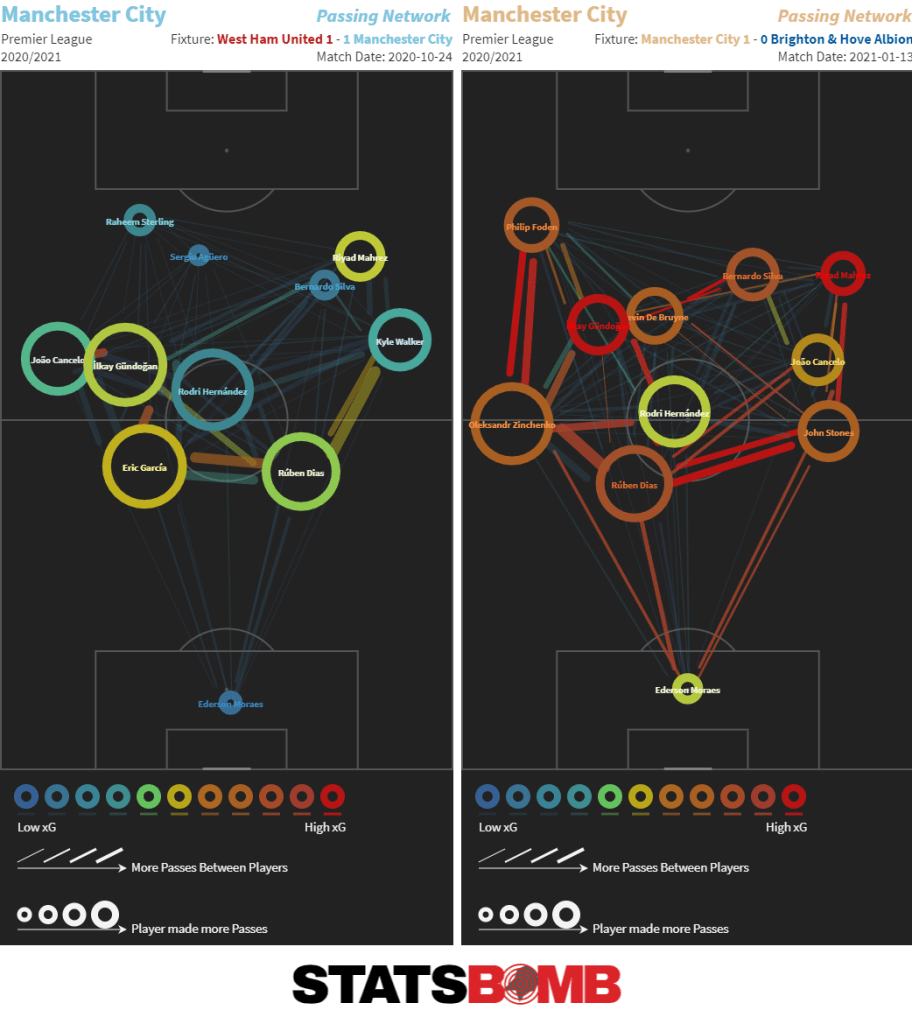
Despite the title win, they finished the season with 83 goals scored – their worst rate for four seasons – and without a 20-goal scorer for the first time since 2012/13. Let’s not skip over the fact: it’s pretty remarkable that *İlkay Gündoğan* was the top scorer with *13* in a title-winning Pep Guardiola side. That they did emerge as champions was mainly down to a defence that conceded a league-low 32 goals in 38 games. And here’s where things get interesting.
For all the tweaks and tightening made to City’s attacking play through the season, their defence also profiled differently from how it has in recent seasons. Previously, City have been such a territory-dominant team that in some games you’d forget that there were even two halves on the pitch. This season, they dialled it down, but only just. Their Defensive Distance – the average distance from a team’s own goal from which it makes defensive actions – remained at a league-high 48.7 metres, in the same range as the previous five seasons. City was still defending as high as ever. The same intensity of counterpressing also remained, but it’s what City did when their opponents beat the initial counterpress that’s worth digging into.
The first hint towards this change is that their PPDA has been in decline for a couple of seasons now, up from 5.45 in 2017/18 to 8.57 in 2020/21. That is to say, their opponents are now able to make ~eight passes per Manchester City defensive action in the 60% of the pitch furthest from City's goal, compared with ~five passes a few seasons ago.
The second is in their Aggression % - the proportion of opponent pass receipts that are tackled, fouled, or pressured within two seconds – has also dropped right off—as high as 28% in 2018/19, but just 21% now.
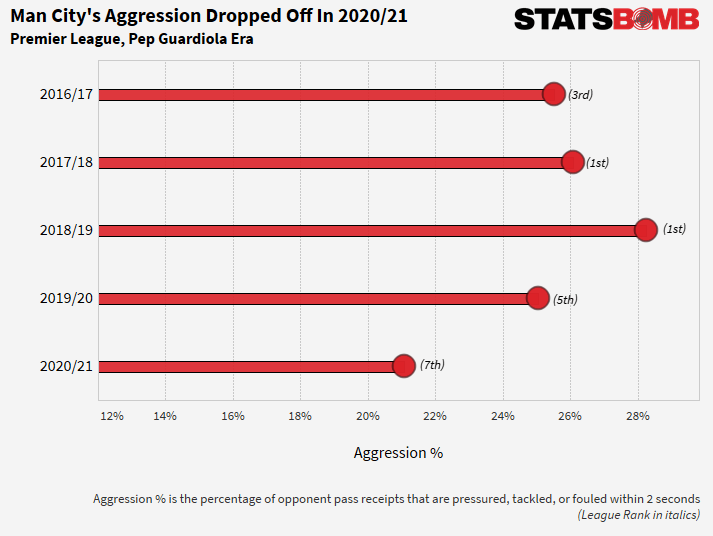
The primary goal of their counterpressing is to win the ball back high up the pitch; the secondary is to prevent and slow the resulting counterattack should the first press not succeed. City have been far better at the latter this season; their in-possession shape lends itself well to funnelling the opposition out to wide areas of the pitch, where it takes longer to advance the ball and reach the goal than it does through the centre.
This is largely the cause of their drop off in PPDA—their opponents aren’t able to attack as quickly or directly, and thus their possession chains are two-to-three passes longer than they were previously able to accrue. Thanks to StatsBomb’s 360 data, we can confirm with data that City crowd out the central areas and ensure they have plenty of cover to prevent the counterattacks they have previously been susceptible to.
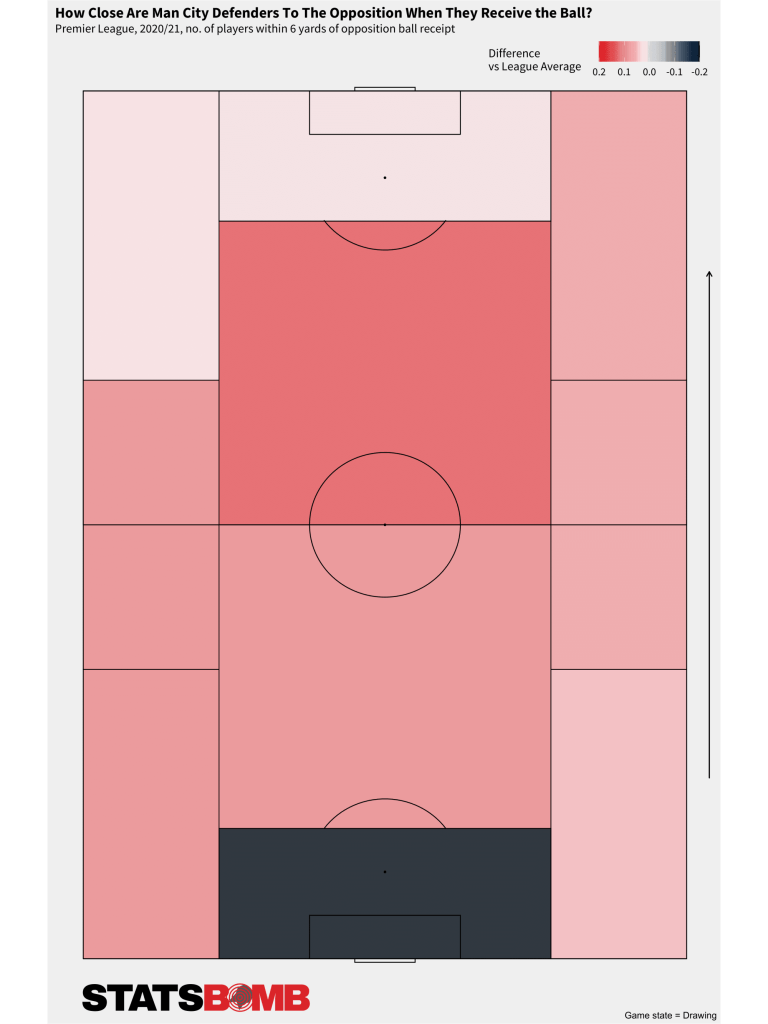
The result of this was that City conceded the fourth-fewest shots on the counter last season. Given they defend higher up the pitch than anyone else in the league, City’s positioning in transition and slowing down of the opponent attacks meant they were able to recover sufficiently to protect the goal. They blocked the highest % of opponent footed shots in the box in the league, and averaged 3.1 defenders behind the ball for these shots.
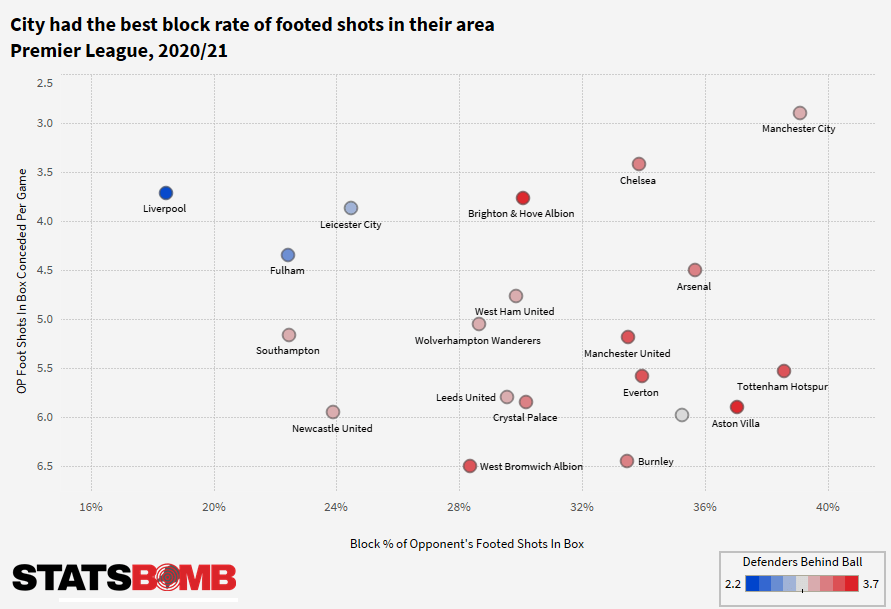
All of this fed into an almighty drop-off in the quality of chances City conceded. In 2019/20, their xG/Shot conceded was league-worst at 0.12. In 2020/21, it was league-best at 0.09. They conceded 7.2 shots per game in both seasons, but the reduction in quality meant their expected goals against dropped from 32.9 to 23.9.
It was a setup that Premier League Player Of The Season Rúben Dias thrived in. Pundits regarded Dias as having a transformative impact on the City defence on his own, but his success was as much down to the system that allowed him to thrive than it was him proving a solid upgrade on their centre half options. Dias ranked third in the league centre backs for Blocks made per shot faced, with 11% of City’s shots faced being blocked by the Portuguese bruiser.
So how do City shape up ahead of next season?
That there have been just two names linked should tell you a lot about the general state of the Manchester City squad. Last season, peak age players utilised plenty of the minutes; they and a few pre-to-early early peak players (Phil Foden, Rodri, Dias) look set to make up the spine of the squad over the next season and more.
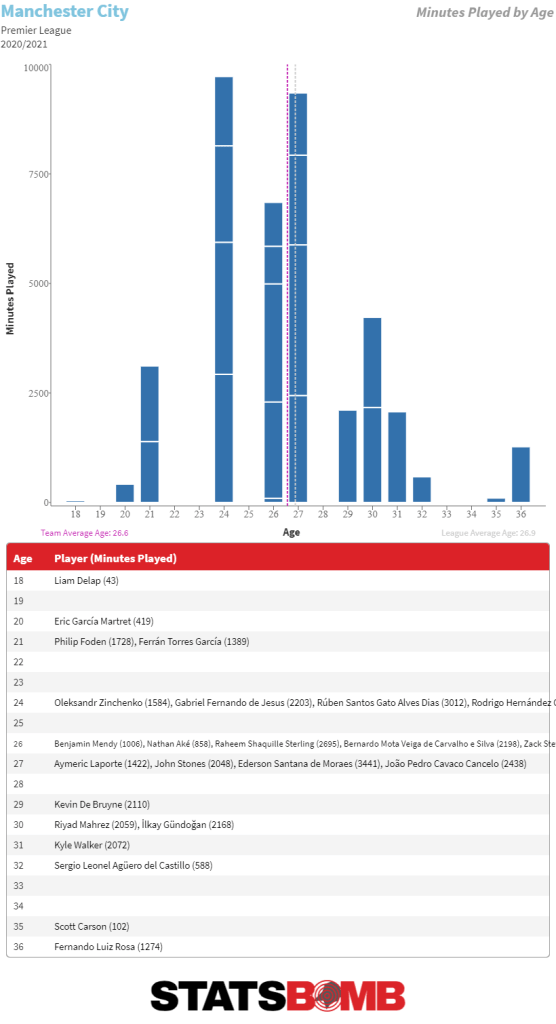
In a summer window that included a delayed Euros and the Olympics, transfer business has understandably been slower to pick up than usual. But the media columns certainly haven’t slowed down in regards to City’s ambition in the market.
As the last shimmerings of Sergio Agüero’s Blue Moon twilight descend over the horizon, there’s a clear question mark over whether - and how - City replace him. Agüero played just 588 minutes last season, so there is a precedent for them coping just fine with Gabriel Jesus and some false 9 play. But this was also their worst attacking season for several years, so it’s no surprise to see rumoured strong interest in one of the best forwards in the world with a skillset to play as both a #9 and a false 9.
The move with seemingly the most wind in the sails is the interest in Jack Grealish. According to reports, negotiations with Aston Villa are well underway. Some may question City’s need for ANOTHER wide forward/advanced midfielder at first glance, but there’s a little more to it.
In terms of output, there are two key attackers for City whom Grealish could look to provide support.
Riyad Mahrez was one of the best ball carriers in the Premier League last season, creating 1.5 shots or key passes per 90 minutes from carries that were >=10m in length. That total put him 4th in the league behind Adama Traoré, Allan Saint-Maximin, and… Jack Grealish, who led the league with 2.1 per 90.
And there’s another key trait that Grealish possesses that would take the strain off another City attacker: Kevin De Bruyne. One of the best in the world, the Belgian’s high-risk passing doesn’t always reach its target, but there’s no question in its value: De Bruyne has been the Premier League’s top creator by xG assisted in three of the last four seasons. It won’t be news to you that he’s responsible for a large slice of City’s creative output.
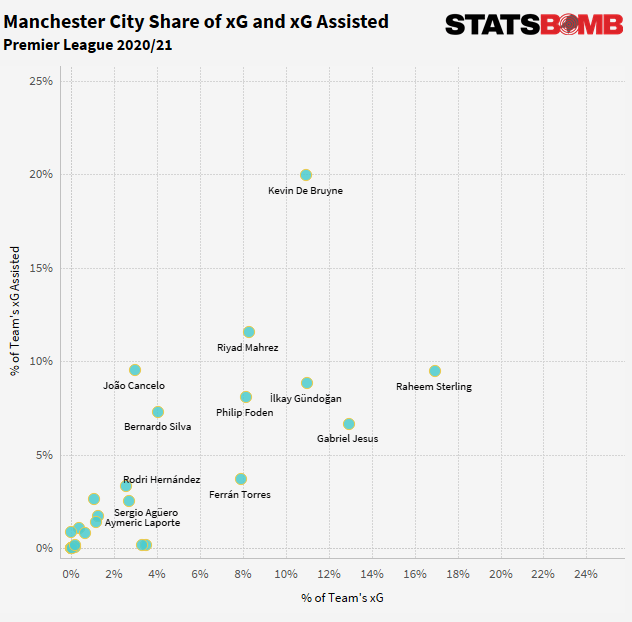
De Bruyne’s vision and ability to drive City towards goal through incisive passing or aggressive running are vital components of the way City move the ball up the pitch. Last season he made 9.6 passes and carries per 90 minutes that moved the ball 25% closer to goal, 2nd in the league and ahead of players such as Trent Alexander-Arnold and Bruno Fernandes (Riyad Mahrez was 4th). The player ahead of him in 1st? Jack Grealish.
The point? Both De Bruyne and Mahrez will hit 30 and 31 next season, so it’s getting to the point where Father Time is going to start tapping his wrist: there’s only so long they can keep up that level of output. In Grealish, they could add someone who brings elements of both players and would be able to contribute both immediately and for the next five seasons, at least.
Projection
Projecting into next season where they could make it four titles in five seasons, the big question remains one that has been asked numerous times in that period: can City be stopped? The spine of the squad is in place with Ederson, Stones and Dias marshalling the defence, Rodri anchoring the midfield, De Bruyne still at the top of his game and talent such as Phil Foden ready to play an increased role next season. There’s enough depth in the squad as it is to rotate minutes, but, given City’s (relative) struggles in attack last season, it’s obvious why at least one key signing in the midfield/attack remains the top priority for the City management.
An 86-point season to win the title was below their Premier-League-greatest-of-all-time best that we saw 2017-2019, but their metrics remained ahead of their competition and were still enough to power them to a league title *and* a Champions League final. Given their historical performances and Guardiola’s form for finding solutions to nearly any tactical conundrum, one wouldn’t predict City to worsen that points tally. So it’s up to Liverpool, Chelsea and Manchester United to raise their game and eclipse what seems an inevitably high benchmark, the signing(s) of one (or two) of the Premier League’s best attackers would only raise that bar.
Want to read about another team? The rest of our Premier League season previews can be found here
If you're a club, media or gambling entity and want to know more about what StatsBomb can do for you, please contact us at Sales@StatsBomb.com
We also provide education in this area, so if this taste of football analytics sparked interest, check out our Introduction to Football Analytics course
Follow us on Twitter in English and Spanish and also on LinkedIn
